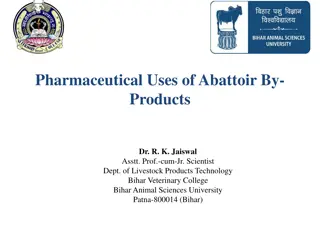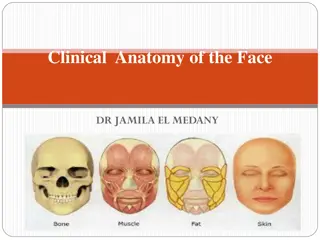Understanding Blepharitis: Anatomy, Structure, and Glands of Eyelids
Blepharitis is a common eye condition characterized by inflammation of the eyelids. This article dives into the anatomy of eyelids, including their structure and the various glands present. It explains the position of eyelids, the canthi, and the palpebral aperture. Additionally, it discusses the Meibomian glands, Glands of Zeis, Glands of Moll, and Accessory lacrimal glands of Wolfring. Details on the blood supply of the lids, including arterial and venous systems, as well as lymphatics, are also provided.
Download Presentation

Please find below an Image/Link to download the presentation.
The content on the website is provided AS IS for your information and personal use only. It may not be sold, licensed, or shared on other websites without obtaining consent from the author. Download presentation by click this link. If you encounter any issues during the download, it is possible that the publisher has removed the file from their server.
E N D
Presentation Transcript
Anatomy of eye lids Parts of eyelid Each eyelid is divided by a horizontal furrow (sulcus) into an orbital and tarsal part. Position of lids When the eye is open, the upper lid covers about one-sixth of the cornea and the lower lid just touches the limbus. Canthi. The two lids meet each other at medial and lateral angles (or outer and inner canthi). The medial canthus is about 2 mm higher than the lateral canthus Palpebral aperture. When the eyes are open it measures about 10-11 mm vertically in the centre and about 28-30 mm horizontally.
STRUCTURE of eye lids 1. Skin 2. Subcutaneous alveolar tissue 3. Layer of striated Muscle 4. Submucosal alveolar tissue 5. Fibrous layer 6. Layer of non striated muscle 7. Conjunctiva
GLANDS OF EYELIDS 1. Meibomian glands. These are also known as tarsal glands and are present in the stroma of tarsal plate arranged vertically. They are about 30-40 in the upper lid and about 20-30 in the lower lid. They are modified sebaceous glands. Their ducts open at the lid margin. Their secretion constitutes the oily layer of tear film. 2. Glands of Zeis. These are also sebaceous glands which open into the follicles of eyelashes
3. Glands of Moll. These are modified sweat glands situated near the hair follicle. They open into the hair follicles or into the ducts of Zeis glands. They do not open directly onto the skin surface as elsewhere. 4. Accessory lacrimal glands of Wolfring. These are present near the upper border of the tarsal plate.
Blood Supply The arteries of the lids(medial and lateral palpebral) form marginal arterial arcades which lie in the submuscular plane in front of the tarsal plate, 2 mm away from the lid margin, in each lid. In the upper lid another arcade (superior arterial arcade) is formed which lies near the upper border of the tarsal plate. Branches go forward and backward from these arches to supply various structures. Veins. These are arranged in two plexuses: a post- tarsal which drains into ophthalmic veins and a pre- tarsal opening into subcutaneous veins.
Lymphatics. These are also arranged in two sets: the pre-tarsal and the post-tarsal. Those from lateral half of the lids drain into preauricular lymph nodes and those from the medial half of the eyelids drain into submandibular lymph nodes.
NERVES OF LIDS Motor nerves are facial (which supplies orbicularis muscle), oculomotor (which supplies LPS muscle) and sympathetic fibres (which supply the Muller s muscle). Sensory nerve supply is derived from branches of the trigeminal nerve.
BLEPHARITIS It is a subacute or chronic inflammation of the lid margins. Seborrhoeic or squamous blepharitis, Staphylococcal or ulcerative blepharitis/bacterial blepharitis Mixed staphylococcal with seborrhoeic blepharitis, Posterior blepharitis or meibomitis, and Parasitic blepharitis.
Bacterial blepharitis Bacterial/chronic anterior/staphylococcal/ulcerative blepharitis Chronic anterior inflammation of lid margin Disorder start from childhood and continue for lifetime
Etiology Causative organisms stephylococci,streptococci;propinobacterial acnes; moraxella Predisposing factor :: chronic conjunctivitis and dacryocystitis
Cinical features Symptoms Chronic irritation Itching Mild lacrimation Gluing of cilia Mild photophobia
Signs Yellow crusts at root of cilia Small ulcers Red thickened lid margins Mild papillary conjunctivitis and conjunctival hyperemia
Complications and sequelae Lash abnormalities madarosis(sparseness or absence of cillia ) trichiasis;poliosis( graying of eye lashes)
Tylosis (thickened and scarred lid margin Eversion of lid margin lid to epiphora Eczema of skin and ectropion may develop prolong watering
Recurrent stye Marginal keratitis Tear film instability Secondary inflammatory and mechanical changes in conjunctiva and cornea
Treatment of bacterial blepharitis Lid hygiene 2 times Warm compression for 5 to 10 min to soften crust Crust removal and lid margin cleaning Avoid rubbing
Antibiotics Eye ointment apply after lid crust remove Eye drops 4 times Oral antibiotics erythromycin 500mg or doxycycline 100mg BID
Topical steroid (low potent) fluorometholone Ocular lubricants if tear film instability or dry eye is there
Seborrhoeic or squamous blepharitis Etiology. It is usually associated with seborrhoea of scalp (dandruff). glands of Zeis secrete abnormal excessive neutral lipids which are split by Corynebacterium acne into irritating free fatty acids.
Symptoms. Patients usually complain of deposition of whitish material at the lid margin associated with mild discomfort, irritation, occasional watering and a history of falling of eyelashes.
Signs. Accumulation of white dandruff-like scales are seen on the lid margin, among the lashes On removing these scales underlying surface is found to be hyperaemic (no ulcers). The lashes fall out easily but are usually replaced quickly without distortion. In long-standing cases lid margin is thickened and the sharp posterior border tends to be
Treatment. General measures include improvement of health and balanced diet. Associated seborrhoea of the scalp should be adequately treated. Local measures include removal of scales from the lid margin with the help of lukewarm solution of 3 percent soda bicarb or baby shampoo and frequent application of combined antibiotic and steroid eye ointment at the lid margin.
Posterior blepharitis (Meibomitis) 1. Chronic meibomitis is a meibomian gland dysfunction, seen more commonly in middle-aged persons with acne rosacea and seborrhoeic dermatitis. It is characterized by white frothy (foam-like) secretion on the eyelid margins and canthi (meibomian seborrhoea). On eversion of the eyelids, vertical yellowish streaks shining through the conjunctiva are seen. At the lid margin, openings of the meibomian glands become prominent with thick secretions
2. Acute meibomitis occurs mostly due to staphylococcal infection.
Treatment of meibomitis consists of expression of the glands by repeated vertical lid massage, followed by rubbing of antibiotic-steroid ointment at the lid margin. Antibiotic eyedrops should be instilled 3-4 times. Systemic tetracyclines for 6-12 weeks remain the mainstay of treatment of posterior blepharitis. Erythromycin may be used where tetracyclines are contraindicated.
Parasitic blepharitis Blepharitis acrica refers to a chronic blepharitis associated with Demodex folliculorum infection and Phthiriasis palpebram to that due to crab-louse, very rarely to the head-louse. In addition to features of chronic blepharitis, it is characterized by presence of nits at the lid margin and at roots of eyelashes
Treatment consists of mechanical removal of the nits with forceps followed by rubbing of antibiotic ointment on lid margins, and delousing of the patient, other family members, clothing and bedding.























